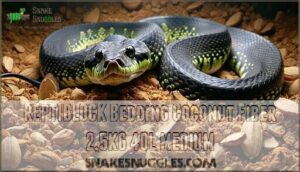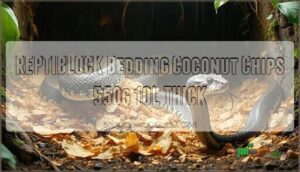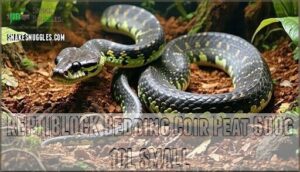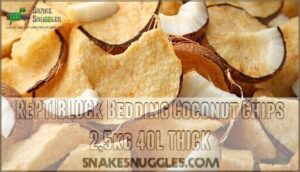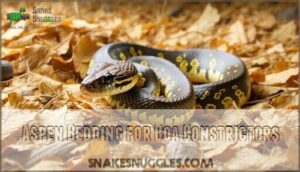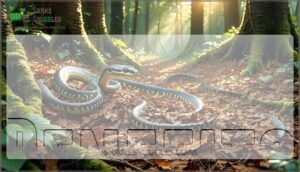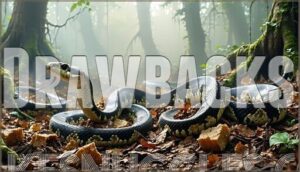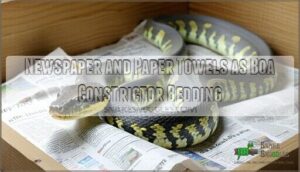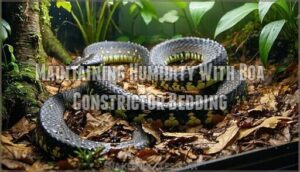This site is supported by our readers. We may earn a commission, at no cost to you, if you purchase through links.
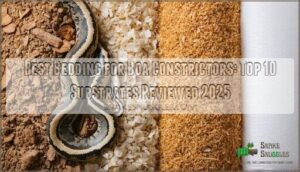 You’ll want to choose the best bedding for boa constrictors based on your snake’s specific needs and your maintenance preferences.
You’ll want to choose the best bedding for boa constrictors based on your snake’s specific needs and your maintenance preferences.
Aspen shavings top the list for easy spot-cleaning and odor control, while coconut fiber excels at holding humidity for proper shedding.
Cypress mulch creates that natural forest floor feel your boa instinctively craves.
Paper towels work perfectly for quarantine or young snakes, though they lack the burrowing opportunities adult boas enjoy.
Avoid cedar or pine shavings—they’re like kryptonite to your snake’s respiratory system.
The right substrate isn’t just bedding; it’s the foundation of your boa’s health and happiness in captivity.
Table Of Contents
- Key Takeaways
- 10 Best Substrates for Boa Constrictors
- 1. Zoo Med Aspen Snake Bedding
- 2. ReptiChip Coconut Chip Bedding
- 3. Kritters Crumble Reptile Substrate
- 4. Prococo Coconut Husk Coir Chips
- 5. Forest Floor Bedding
- 6. Zoo Med Eco Earth Coconut Fiber
- 7. Zoo Med Eco Earth Brick
- 8. Kempf Compressed Coco Coir
- 9. Zoo Med Eco Earth Substrate
- 10. Bounty Paper Towels 12 Pack
- Choosing The Right Substrate for Boa Constrictors
- Coconut Fiber Substrates for Boa Constrictors
- Aspen Bedding for Boa Constrictors
- Cypress Mulch and Boa Constrictors
- Newspaper and Paper Towels as Boa Constrictor Bedding
- Maintaining Humidity With Boa Constrictor Bedding
- Frequently Asked Questions (FAQs)
- What is the best material for a boa enclosure?
- What is the best substrate for Colombian boas?
- What bedding is the best for snakes?
- What do boas like in their cage?
- What is the best substrate for common boas?
- What kind of bedding is best for snakes?
- What is the best mulch for boas?
- What is the best setup for a boa constrictor?
- What kind of substrate do boa constrictors need?
- Do Boas need a constrictor?
- Conclusion
Key Takeaways
- Choose substrate based on your boa’s humidity needs – Coconut fiber and cypress mulch excel at maintaining the crucial 50-70% humidity levels your snake requires for healthy shedding, while aspen shavings work better for easy cleanup but won’t help with moisture retention.
- Avoid cedar and pine shavings completely – These materials contain toxic oils that’ll damage your boa’s respiratory system and can cause serious health problems, so stick with safe options like aspen, coconut fiber, or cypress mulch instead.
- Consider your maintenance preferences when selecting bedding – Paper towels offer the easiest cleanup and work great for quarantine situations, while natural substrates like coconut fiber require more effort but provide better enrichment and humidity control.
- Match substrate depth to your snake’s size and needs – You’ll want 2-3 inches for juveniles to prevent impaction risks, while adult boas benefit from 4-6 inches that allows proper burrowing behavior and maintains stable temperature gradients.
10 Best Substrates for Boa Constrictors
You’ll find ten proven substrate options that keep your boa constrictor healthy and comfortable in their enclosure.
These bedding choices range from budget-friendly paper towels to premium coconut fiber blends, each offering specific benefits for humidity control, easy cleaning, and snake safety.
1. Zoo Med Aspen Snake Bedding
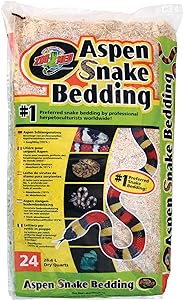
Zoo Med Aspen Snake Bedding hits the sweet spot for boa constrictors who need reliable substrate without breaking the bank.
You’ll love its 191% absorbency rating that makes cleanup a breeze when your snake leaves surprises. This dust-free bedding won’t irritate your boa’s respiratory system, and it’s lightweight enough that cage maintenance won’t wear you out.
The natural wood texture lets your snake burrow and nest like they’d in the wild. It’s odorless and chemical-free, so you don’t have to worry about toxic oils harming your pet.
Professional herpetoculturists worldwide choose this substrate for good reason.
Best For: Boa constrictors and other reptiles requiring a reliable, natural substrate that supports burrowing and nesting.
- Requires weekly replacement to prevent moisture buildup.
- Not suitable for high-humidity enclosures.
- May be less cost-effective compared to bulkier substrates.
- Excellent 191% absorbency for easy cleanup.
- Dust-free and odorless for a safe, clean environment.
- Made from 100% natural, chemical-free aspen wood.
2. ReptiChip Coconut Chip Bedding
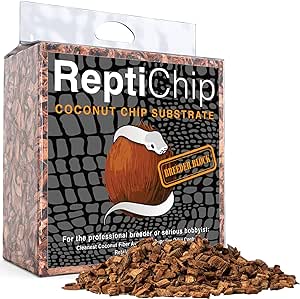
Coming from sustainable coconut husks, ReptiChip Coconut Chip Bedding delivers exceptional performance for your boa constrictor’s habitat.
This 100% organic substrate excels at humidity retention and odor absorption, creating the ideal environment your snake needs.
It’s completely dust-free, protecting your boa’s respiratory system from irritation.
While it’s pricier than basic options and can be challenging to remove when dry, the benefits outweigh these minor drawbacks.
You’ll appreciate how one compressed brick expands to cover large enclosures efficiently.
Just watch for occasional sharp pieces during handling, and you’ll have a top-tier substrate that keeps your boa healthy and comfortable.
Best For: Reptile owners looking for an organic, high-performance substrate that retains humidity and minimizes odors, suitable for species like boa constrictors.
- Pricier than standard substrate options.
- Occasional sharp pieces requiring careful handling.
- Can be challenging to remove when dry.
- Exceptional humidity retention and odor absorption for an optimal habitat.
- Dust-free, reducing respiratory health risks for reptiles.
- Expands efficiently to cover large enclosures.
3. Kritters Crumble Reptile Substrate
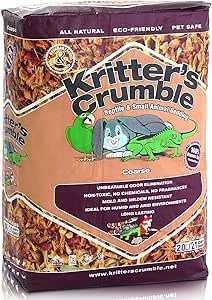
With its 100% organic coconut husk fiber composition, Kritters Crumble Reptile Substrate delivers exceptional moisture retention for your boa’s habitat.
You’ll appreciate how it holds humidity levels between 50-70% while maintaining excellent odor control.
This dust-free substrate won’t irritate your snake’s respiratory system, and its natural texture encourages healthy burrowing behaviors.
The biodegradable material makes cleanup straightforward – simply spot-clean soiled areas and replace sections as needed.
Its earth-like appearance creates an authentic terrarium environment that keeps your boa comfortable and stress-free.
Best For: Reptile owners, especially those with boa constrictors, looking for an organic, moisture-retentive, and odor-controlling substrate.
- May require drying before use due to initial moisture content.
- Some users report springtail pods, which might be off-putting.
- Can be expensive compared to other substrate options.
- Exceptional moisture retention to maintain ideal humidity levels.
- Dust-free with a natural texture that supports burrowing behaviors.
- Biodegradable and environmentally friendly.
4. Prococo Coconut Husk Coir Chips
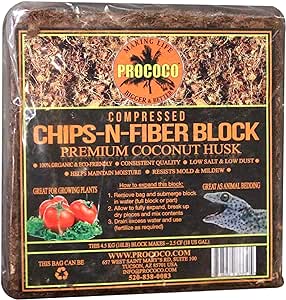
While other substrates can disappoint, Prococo Coconut Husk Coir Chips deliver consistent performance for your boa’s habitat.
This 100% organic substrate expands to 75 quarts when hydrated, providing excellent moisture retention that maintains 60-70% humidity levels.
The medium-grind texture creates perfect burrowing conditions while staying mold-resistant and odor-absorbing.
You’ll appreciate its natural antimicrobial properties that reduce bacterial growth.
For optimal health, remember essential humidity control is necessary for shedding and respiratory well-being.
Though initial hydration takes time, these chips last 4-5 years and support healthy shedding cycles.
The pH-neutral formula won’t irritate sensitive skin, making it ideal for young boas.
Best For: Boa constrictor owners seeking a natural, eco-friendly substrate that ensures proper humidity, burrowing, and shedding conditions.
- Requires initial hydration before use.
- Can take time to dry properly for storage.
- Medium grind may not suit reptiles preferring finer substrates.
- Excellent moisture retention that maintains 60-70% humidity.
- Odor-absorbing, mold-resistant, and naturally antimicrobial.
- Long-lasting and biodegradable, suitable for eco-conscious users.
5. Forest Floor Bedding
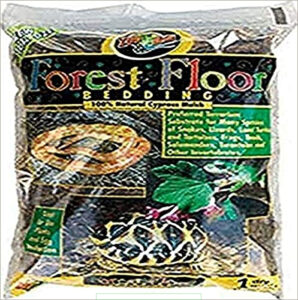
Forest Floor Bedding brings the wilderness directly into your boa’s home. This natural cypress mulch substrate creates an authentic "forest floor" appearance while delivering excellent moisture retention for proper humidity control.
You’ll find it particularly helpful during shedding season, as the retained moisture makes the process smoother for your snake. The substrate maintains that essential 60-70% humidity range boa constrictors need without becoming soggy.
It’s perfect for tropical species and works well with amphibians too. However, cleaning requires more effort than simpler substrates. You’ll need to spot-clean regularly and replace sections that become too moist to prevent mold growth.
Despite the extra maintenance, many keepers swear by forest floor bedding for its natural look and humidity benefits. Your boa will appreciate the familiar texture under its belly.
Best For: Reptile and amphibian keepers looking for a natural substrate that provides excellent moisture retention and mimics a forest floor environment.
- Requires frequent cleaning and replacement to prevent mold growth.
- More expensive than standard synthetic substrates.
- Demands careful preparation and sourcing to ensure quality.
- Maintains optimal humidity levels for boa constrictors and tropical species.
- Enhances natural behaviors like burrowing and shedding.
- Creates an authentic, naturalistic terrarium appearance.
6. Zoo Med Eco Earth Coconut Fiber
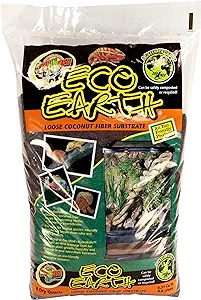
Looking for a substrate that’ll make your boa constrictor feel right at home? Zoo Med Eco Earth Coconut Fiber stands out as one of the best beddings available.
This excellent substrate comes from 100% natural coconut husks, creating an eco-friendly option that won’t harm the environment.
What makes this substrate shine? It absorbs moisture like a champ while maintaining perfect humidity levels for your snake.
You’ll love how dust-free it stays, making cleanup a breeze and keeping your boa’s respiratory system happy. The soft, fluffy texture lets your snake burrow naturally, reducing stress and mimicking their wild habitat.
This substrate works amazingly for creating a naturalistic terrarium setup that’ll have your boa thriving.
Best For: Tropical reptile species like boa constrictors, leopard geckos, and other burrowing reptiles needing high humidity and naturalistic habitats.
- Prone to mold if kept too damp.
- Not resealable, requiring taping for storage.
- Loose fibers may stick to prey during feeding.
- Retains moisture effectively, ensuring optimal humidity levels.
- Soft texture allows natural burrowing and stress relief.
- Eco-friendly and biodegradable, made from 100% natural coconut fiber.
7. Zoo Med Eco Earth Brick
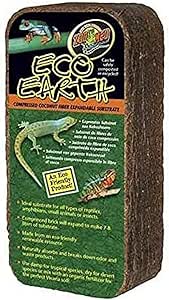
Zoo Med Eco Earth Brick transforms your boa’s habitat with compressed coconut fiber that’s both practical and effective.
You’ll get 7-8 liters of substrate from each compact brick – just add water and watch it expand.
This natural material excels at maintaining the 50-60% humidity your boa needs for healthy shedding cycles.
The soft texture allows natural burrowing behaviors while absorbing waste and controlling odors.
It’s cost-effective compared to loose substrates and won’t compact if accidentally ingested.
Plus, cleanup’s straightforward with spot-cleaning capabilities that keep maintenance simple and your snake comfortable.
Best For: Reptile owners seeking an affordable, natural substrate to maintain humidity and enhance their pets’ habitat.
- Expands to 7-8 liters, providing excellent value and coverage.
- Maintains consistent humidity and controls odors effectively.
- Soft texture supports burrowing and natural behaviors.
- Requires hydration before use, adding preparation time.
- Can be messy during setup and hydration process.
- Potential for mold growth if over-saturated.
8. Kempf Compressed Coco Coir
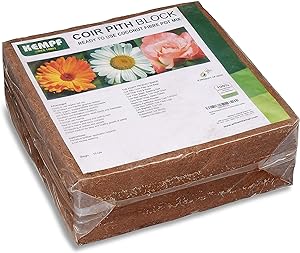
This coconut husk fiber substrate offers excellent value for boa constrictor owners who want quality without breaking the bank.
You’ll get impressive expansion when you hydrate the compressed brick – it grows to 18 gallons from a compact 10-pound block that measures just 11 x 11 x 5 inches.
The pH-neutral formula won’t disrupt your snake’s environment, while the natural antimicrobial properties help prevent mold growth.
You can maintain that essential 60-70% humidity range easily since coconut coir holds moisture exceptionally well.
Your boa will appreciate the natural texture for burrowing, and you’ll love how simple cleanup becomes.
Storage is a breeze with the compressed format, and the natural look enhances your terrarium’s appearance.
It’s chemical-free, environmentally friendly, and provides consistent performance that keeps both you and your snake happy.
Best For: Reptile enthusiasts, especially boa constrictor owners, seeking a natural, eco-friendly substrate that maintains humidity and supports burrowing behavior.
- Requires careful hydration and preparation before use.
- Tall containers can lead to uneven expansion or container failure during hydration.
- Coarser texture may not suit users needing a finer substrate.
- Expands to 18 gallons from a compact, easy-to-store 10-pound brick.
- Maintains 60-70% humidity and prevents mold with antimicrobial properties.
- Provides a natural look, ideal for burrowing and terrarium enrichment.
9. Zoo Med Eco Earth Substrate
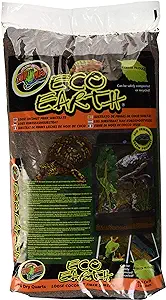
This coconut fiber substrate stands out as an excellent choice for your boa constrictor’s habitat.
Ecologically friendly and renewable, Zoo Med Eco Earth effectively maintains proper humidity levels that keep your snake healthy and comfortable.
The natural material breaks down waste and controls odors, making cleanup much easier than traditional bedding options.
Your boa will love burrowing into this soft substrate, which mimics their natural forest floor environment.
The rich brown color beautifully highlights your snake’s natural patterns and coloring.
Keep the substrate slightly damp to maximize humidity retention and prevent unwanted pests like gnats.
Replace the bedding every six months to maintain ideal conditions.
This substrate’s versatility works well for multiple reptile species, making it a smart investment for any reptile keeper’s collection.
Best For: Owners of burrowing reptiles, amphibians, and invertebrates looking for a natural, eco-friendly substrate.
- Requires careful monitoring to avoid mold if kept too damp.
- Loose fibers may stick to prey items during feeding.
- Not resealable, requiring taping for storage after opening.
- Maintains proper humidity levels and prevents rapid fluctuations.
- Soft, comfortable surface ideal for burrowing and movement.
- Eco-friendly, biodegradable, and renewable material.
10. Bounty Paper Towels 12 Pack
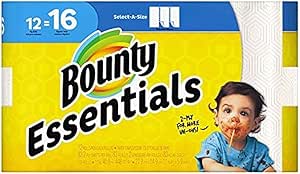
You might wonder why paper towels made this list, but they’re surprisingly useful for boa owners.
Bounty Paper Towels work perfectly for quarantine setups and medical monitoring since you can spot health issues immediately on the clean white surface.
They’re incredibly easy to replace – just roll out fresh sheets when needed.
While they don’t retain humidity like natural substrates, they excel for temporary housing situations.
Each 12-pack provides excellent value, and the spot cleaning process becomes effortless when accidents happen.
Best For: Boa constrictor owners needing a disposable, clean, and simple substrate for quarantine or temporary setups.
- Does not retain humidity, requiring frequent misting.
- Lacks natural texture, which may cause stress for snakes.
- Not suitable for long-term or tropical-environment use.
- Highly absorbent and easy to replace for quick cleanup.
- Helps with immediate detection of waste and health issues.
- Cost-effective and convenient for short-term use.
Choosing The Right Substrate for Boa Constrictors
You’ll need to balance several key factors when selecting the perfect substrate for your boa constrictor’s home.
The right bedding choice affects your snake’s health through humidity control, ease of cleaning, and safety from harmful materials or impaction risks.
Humidity Requirements
Your boa’s respiratory health depends on maintaining proper humidity levels between 50-60% normally, increasing to 60-70% during shedding support periods.
Smart substrate choice makes all the difference – coconut fiber, cypress mulch, and orchid bark excel at moisture retention. Monitor humidity with digital gauges for accurate readings.
Optimal humidity helps prevent shedding issues.
Substrate choices: Coconut fiber, orchard bark, cypress mulch.
- Misting frequency: Daily for shedding.
- Bedding depth: Varied to retain moisture
- Peace of mind: Proper humidity control prevents costly vet visits from respiratory infections
- Watching your snake thrive: Successful sheds mean your boa feels secure and healthy in their environment
Ease of Cleaning
Cleaning shouldn’t feel like a chore when you’re caring for your boa.
Spot cleaning becomes effortless with substrates that clump around waste, making odor control simple. Easy to clean reptile bedding saves time and reduces stress.
Paper towels offer quick substrate replacement, while coconut fiber excels at waste management. Choose enclosure cleaning methods that fit your schedule and keep your boa healthy.
Coconut Fiber Substrates for Boa Constrictors
Coconut fiber substrates offer you excellent humidity control and natural burrowing opportunities that closely match your boa’s wild habitat needs.
You’ll find these eco-friendly options absorb moisture effectively while providing the soft, comfortable surface your snake requires for healthy shedding and movement, which includes natural burrowing opportunities.
REPTIBLOCK Bedding Coconut Fiber 2,5KG 40L MEDIUM
When selecting boa bedding, REPTIBLOCK’s medium coconut fiber delivers exceptional water retention for your snake’s habitat.
This reptile bedding option stands out among coconut fiber substrates for several reasons:
- Fiber Size creates ideal burrowing texture
- Superior moisture control maintains proper humidity
- Burrowing Potential satisfies natural instincts
- Minimal impaction risks compared to coarser alternatives
- Cost Analysis shows excellent value per liter
This boa constrictor bedding provides the perfect balance between comfort and functionality for your pet’s enclosure.
Consider its chewy texture options for varied enrichment.
REPTIBLOCK Bedding Coconut Chips 550g 10L THICK
REPTIBLOCK’s chunky coconut chips deliver excellent Chip Size for your boa’s burrowing needs.
This snake substrate excels at Humidity Control while minimizing Impaction Risks compared to finer materials.
You’ll find it works beautifully in Bioactive Setups, supporting beneficial microorganisms.
The coconut fiber composition provides superior heat and humidity retention for your snake’s comfort.
Many reptile owners source coconut chip substrate for its versatile applications.
Cost Analysis shows good value at 550g for smaller enclosures needing premium boa bedding.
REPTIBLOCK Bedding Coir Peat 600g 10L SMALL
Coir peat delivers fine-textured comfort your boa constrictor will appreciate.
This REPTIBLOCK option provides excellent humidity regulation while supporting natural burrowing suitability. You’ll find this coconut fiber substrate perfect for boa constrictor care, especially when maintaining proper moisture levels.
You can purchase reptiblock coir peat online.
Here’s what makes this substrate shine:
- Superior moisture absorption – Holds humidity longer than coarse alternatives
- Natural burrowing texture – Fine consistency mimics forest floor conditions
- Versatile mixing potential – Blends well with other substrate types
- Space-efficient storage – Compact packaging expands when hydrated
REPTIBLOCK Bedding Coconut Chips 2,5kg 40L THICK
While coir peat works well for smaller setups, REPTIBLOCK Bedding Coconut Chips 2.5kg 40L THICK takes your boa constrictor bedding to the next level.
The larger chip size creates excellent humidity control while reducing impaction risk compared to finer substrates.
This coconut fiber substrate offers impressive bioactive potential and superior drainage.
Proper humidity is essential for healthy shedding cycles.
Though Reptichip alternatives exist, this substrate delivers solid boa constrictor care with reasonable cost analysis for serious keepers.
Aspen Bedding for Boa Constrictors
You’ll find aspen bedding stands out as one of the most affordable and dust-free substrate options for your boa constrictor’s enclosure.
This natural wood shaving creates a clean environment that’s easy to spot-clean, though it won’t help maintain humidity levels like other substrates, making it a notable choice for its affordability.
Brands/ Where to Buy
You can find quality aspen bedding for boa constrictors at major online retailers like Petco, Amazon, and Chewy.
Local shops often stock Zoo Med and Kaytee brands. Before bulk buying, check product reviews for odor control and dust levels.
Brand comparison shows Zoo Med offers consistent quality, while Reptichip provides excellent value. Some keepers create DIY substrates mixing aspen with cypress mulch.
Proper bedding selection is vital for your snake’s health and comfort. Always buy from reputable pet stores to guarantee chemical-free bedding for your snake’s health.
Pros
Now that you know where to buy aspen bedding, let’s explore why it’s such a popular choice for boa constrictors.
You’ll find several compelling advantages that make this substrate stand out from other options.
Aspen bedding offers excellent value for your money while providing safe materials that won’t harm your snake.
Here’s what makes it shine:
- Easy cleanup – Spot-clean waste quickly without replacing the entire substrate
- Natural aesthetics – Creates a forest floor appearance that mimics your boa’s natural habitat
- Heat retention – Maintains consistent temperatures, reducing heating costs
This bedding supports natural burrowing behaviors while staying odor-resistant and biodegradable, making maintenance simple for busy snake owners.
Cons
Despite its popularity, aspen bedding has significant drawbacks.
Poor humidity control tops the list—it doesn’t retain moisture like coconut fiber.
Dust content can irritate your boa’s respiratory system.
Mold growth becomes problematic when wet, creating health hazards.
There’s also impaction risk if your snake ingests particles during feeding.
Chemical concerns arise with cheaper brands, and mites sometimes hitchhike in bags.
Cost analysis shows you’ll need frequent replacements, making it expensive long-term.
Cypress Mulch and Boa Constrictors
Cypress mulch offers excellent moisture retention and natural forest-floor appearance that many boa owners appreciate.
You’ll find this substrate maintains humidity well, though you should watch young snakes carefully since large pieces can pose an impaction risk if eaten.
Benefits
Cypress mulch offers impressive advantages for your boa constrictor’s habitat.
Your boa deserves a substrate that mimics nature while keeping maintenance simple and stress-free.
This nontoxic bedding excels at humidity control, maintaining the 60-70% levels your snake needs.
You’ll appreciate its superior heat retention properties, which support temperature regulation throughout the enclosure.
The mulch’s texture encourages natural burrowing behavior, letting your boa express instinctive movements.
Cost effectiveness makes it budget-friendly, while excellent odor control keeps your space fresh.
Boa constrictors also benefit from consistent UVB lighting to maintain a proper day/night cycle.
Key benefits include:
- Forest-floor appearance that mimics natural habitat
- Pleasant cedar-like scent that masks snake odors
- Long-lasting durability reducing replacement frequency
- Excellent moisture absorption for cleaning ease
Drawbacks
While cypress mulch offers benefits, it comes with notable drawbacks for boa constrictors.
Impaction risk increases if your snake ingests large chunks during feeding. Chemical exposure from untreated mulch can cause skin irritation.
Cleaning difficulty arises because cypress retains moisture, potentially leading to mold growth.
Additionally, dust content may trigger respiratory issues, making humidity control challenging for sensitive snakes.
Newspaper and Paper Towels as Boa Constrictor Bedding
You can’t beat newspaper and paper towels for simplicity when you’re starting out with boa constrictors or need a clean setup during quarantine periods.
These basic paper options won’t win any beauty contests, but they’re cheap, safe, and make cleaning up after your snake as easy as rolling up the mess and tossing it out.
Advantages
Cost effectiveness makes newspaper and paper towels unbeatable for boa constrictors seeking safe materials on a budget.
You’ll appreciate the ease maintenance – simply toss and replace when soiled.
These substrates let you monitor your snake’s reptile health easily by spotting changes in waste or behavior.
While they don’t mimic natural habitat, they provide reliable snake comfort and cleanliness.
Disadvantages
While budget-friendly, newspaper and paper towels come with significant drawbacks you can’t ignore.
These materials offer zero mold resistance and create humidity issues since they can’t maintain proper moisture levels.
You’ll face maintenance difficulty with frequent replacements, plus they lack odor control entirely.
The sterile appearance creates stress for your boa, who needs naturalistic environments.
Without aesthetic appeal, your enclosure looks clinical rather than inviting.
Most importantly, wet paper can harbor bacteria, potentially causing digestive issues if your snake contacts contaminated surfaces during feeding time.
Maintaining Humidity With Boa Constrictor Bedding
You’ll need to keep your boa’s humidity between 50-60% for ideal health, and the right bedding makes this much easier to achieve.
Coconut fiber substrates and cypress mulch naturally hold moisture better than paper towels or aspen shavings, so you won’t have to mist as often, which helps maintain the ideal humidity level with less effort.
Misting Techniques
While newspaper and paper towels won’t retain moisture naturally, you can boost humidity levels through smart misting strategies.
Start with once-daily misting frequency and adjust based on your hygrometer readings. Water quality matters—use filtered or dechlorinated water to prevent harmful chemicals from affecting your boa’s respiratory system.
Equipment choices range from simple spray bottles to automated reptile humidity systems. Application methods should create a fine mist rather than heavy droplets.
Target boa constrictor humidity between 50-70%, monitoring closely during shed cycles when higher moisture becomes necessary for healthy skin removal.
Substrate Depth
Once you’ve mastered your misting technique, substrate depth becomes your next game-changer for boa constrictors.
Proper bedding depth directly impacts humidity gradient and temperature stability in your enclosure setup.
Here’s what you need to examine for ideal substrate depth:
- Juvenile boas: 2-3 inches allows safe burrowing needs while preventing impaction risk
- Adult boas: 4-6 inches accommodates snake size and natural behaviors
- Bioactive setups: 6+ inches supports plant roots and beneficial microorganisms
Deeper substrate retains moisture longer but risks waterlogging.
Shallower bedding dries quickly, requiring frequent misting adjustments.
Frequently Asked Questions (FAQs)
What is the best material for a boa enclosure?
Don’t put all your eggs in one basket when choosing boa enclosure materials.
You’ll want aspen shavings, coconut fiber, or cypress mulch for substrate.
These maintain proper humidity while preventing impaction risks in your snake.
What is the best substrate for Colombian boas?
You’ll want cypress mulch or coconut fiber for your Colombian boa.
These substrates hold humidity well, allow burrowing, and resist mold.
Avoid cedar shavings and sand—they’re risky for your snake’s health.
What bedding is the best for snakes?
Looking for snake bedding that won’t break the bank?
You’ll want aspen shavings, cypress mulch, or coconut fiber.
These options control humidity, absorb waste easily, and keep your slithery friend comfortable without risking impaction.
What do boas like in their cage?
Boas love secure hiding spots, proper substrate for burrowing, consistent temperatures around 80-88°F, humidity levels at 50-60%, fresh water bowls, and climbing branches.
You’ll create their perfect home with these essentials.
What is the best substrate for common boas?
Around 70% of boa health issues stem from poor substrate choices.
You’ll want aspen shavings or cypress mulch for your common boa—they’re safe, maintain proper humidity, and won’t cause impaction like sand.
What kind of bedding is best for snakes?
You’ll find aspen shavings work best for most snakes since they’re dust-free and absorb moisture well.
Coconut fiber and cypress mulch also excel at maintaining proper humidity levels while staying clean.
What is the best mulch for boas?
Cypress mulch tops the list for boa constrictors—it’s like hitting the jackpot for humidity control.
You’ll love how it holds moisture perfectly while smelling fresh and providing excellent drainage for your snake’s comfort.
What is the best setup for a boa constrictor?
You’ll need a 40-gallon tank minimum, with cypress mulch or aspen bedding.
Hiding spots on both ends, water dish, under-tank heater maintaining 78-88°F, and 50-60% humidity levels are necessary.
For peak health, it is crucial to maintain these conditions.
What kind of substrate do boa constrictors need?
Coincidentally, your boa’s substrate choice mirrors your home’s flooring needs.
You’ll want aspen shavings, cypress mulch, or coconut fiber for ideal humidity control.
These materials prevent impaction while maintaining the 50-60% humidity levels your snake requires.
Do Boas need a constrictor?
No, boas don’t need a separate constrictor device. They’re natural constrictors themselves, using their powerful muscles to squeeze prey. You’re thinking of the snake’s hunting method, not equipment they require.
Conclusion
Your snake’s comfort depends on making the right choice.
Take Sarah’s red-tail boa, who struggled with shedding issues until she switched from pine shavings to coconut fiber – suddenly, perfect sheds every time.
The best bedding for boa constrictors balances humidity retention, cleanliness, and safety.
Whether you choose aspen for easy maintenance, coconut fiber for moisture control, or cypress mulch for natural appeal, avoid harmful cedar and pine.
Your boa’s health starts with proper substrate selection.
- http://www.hardinherpetologica.com/husbandry
- https://www.quora.com/What-type-of-substrate-is-best-used-for-a-pet-snakes-habitat
- https://www.westindianboas.org/vivarium-keeping/requirements-for-keeping-west-indian-boas/
- https://reptilesmagazine.com/rosy-boa-care-sheet/?srsltid=AfmBOoqPBnZL140xb_oWtg9Aqpdn6V-0Y99mkOdChja0veC0m2v38RRy
- https://talis-us.com/blogs/news/create-a-comfortable-habitat-with-zoo-med-snake-bedding?srsltid=AfmBOoqhHz3sViEmYnWkwkWauI0hBJPzVqtMWAI9O3MqE9zE8TfZPBqN

